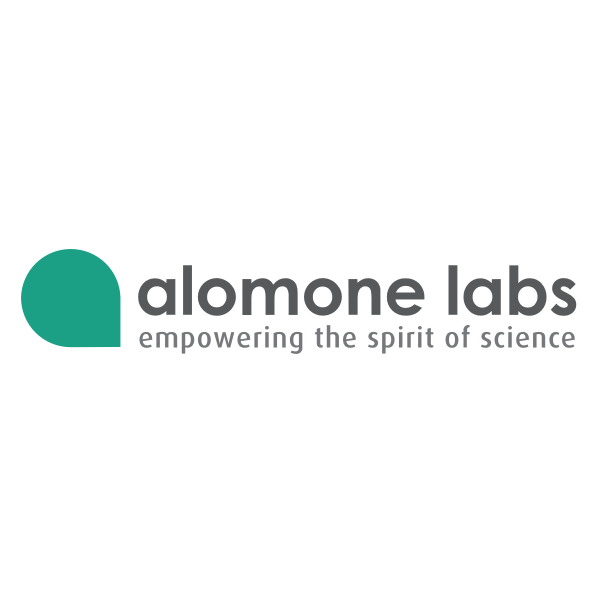

品牌: Alomone
 下载产品说明书
下载产品说明书 用小程序,查商品更便捷
用小程序,查商品更便捷



 收藏
收藏
 对比
对比 咨询
咨询纯度:
Affinity purified on immobilized antigen.
Affinity purified on immobilized antigen.
反应种属:
M, R
M, R
产品介绍
产品信息
纯化方式
Affinity purified on immobilized antigen.

宿主
兔

免疫原
Peptide (C)RSKKLEHSHDPFN, corresponding to amino acid residues 68-80 of rat KCNE1 (Accession P15383). Intracellular, C-terminus.

简单描述
A Rabbit Polyclonal Antibody to KCNE1

商品描述
Alomone Labs is pleased to offer a highly specific antibody directed against an epitope of rat KCNE1. Anti-KCNE1 (IsK) Antibody (#APC-163) can be used in western blot analysis. It has been designed to recognize KCNE1 from rat, mouse and human samples.

同种型
Rabbit IgG.

纯度
Affinity purified on immobilized antigen.

形式
Lyophilized

组成成分
抗最小钾通道蛋白抗体,0.05%叠氮化钠溶液

基因
KCNE1

应用
实验应用
WB

反应种属
M, R

预测反应种属
H

背景
别名
Delayed rectifier potassium channel subunit IsK, Minimal potassium channel, MinK

背景
Potassium delayed rectifier channels are a sub-type of potassium channels found in various species of animals and they are responsible for the late-repolarization phase and the duration of action potential, especially in cardiac myocyte.
There are two types of delayed rectifier channels (Ik). The Fast component is known as Ikr and is encoded by the gene KCNH2 in Xenopus. This channel’s α-subunit is a 6-transmembrane domains voltage dependent potassium channel and its regulatory β-subunit, MiRP1, is required to reconstitute native Ikr1.
KCNE1 and KCNQ1 are the genes encoding the two components of the Iks channel and this association was not fully understood for a long time. KCNQ1 (KV7.1) is a protein with six transmembrane domains and a typical pore loop containing a potassium signature sequence.
The KNCE1 gene encodes the protein “minK”. This gene is one of family of genes that encode small channel subunits (smaller than 130 amino-acids) that co-assemble with bigger subunits thus changing channel gating properties. These are currently the smallest known potassium channel subunits. Their small size and putative transmembrane domain prevent them from forming channels on their own. In addition, in an experiment where mammalian cells were transfected with mink, no K+ currents were observed. When transfecting cells with a combination of KNCE1 and KNCQ1 the currents observed were up to ten times larger than currents induced by the KNCQ1 subunit alone2.
The loss of function of Iks is tightly linked with the long QT syndrome and bilateral deafness and gain of function was found to be linked with cardiac tachy-arrhythmias3,4.
There are two types of delayed rectifier channels (Ik). The Fast component is known as Ikr and is encoded by the gene KCNH2 in Xenopus. This channel’s α-subunit is a 6-transmembrane domains voltage dependent potassium channel and its regulatory β-subunit, MiRP1, is required to reconstitute native Ikr1.
KCNE1 and KCNQ1 are the genes encoding the two components of the Iks channel and this association was not fully understood for a long time. KCNQ1 (KV7.1) is a protein with six transmembrane domains and a typical pore loop containing a potassium signature sequence.
The KNCE1 gene encodes the protein “minK”. This gene is one of family of genes that encode small channel subunits (smaller than 130 amino-acids) that co-assemble with bigger subunits thus changing channel gating properties. These are currently the smallest known potassium channel subunits. Their small size and putative transmembrane domain prevent them from forming channels on their own. In addition, in an experiment where mammalian cells were transfected with mink, no K+ currents were observed. When transfecting cells with a combination of KNCE1 and KNCQ1 the currents observed were up to ten times larger than currents induced by the KNCQ1 subunit alone2.
The loss of function of Iks is tightly linked with the long QT syndrome and bilateral deafness and gain of function was found to be linked with cardiac tachy-arrhythmias3,4.

制备和贮存
溶解方法
25 µl, 50 µl or 0.2 ml double distilled water (DDW), depending on the sample size.

保存方式
The antibody ships as a lyophilized powder at room temperature. Upon arrival, it should be stored at -20°C.
数据库链接
Entrez-Gene ID
25471

UniProt ID
P15383

研究资源识别码
AB_2756750.

声明 :本官网所有报价均为常温或者蓝冰运输价格,如有产品需要干冰运输,需另外加收干冰运输费。







 危险品化学品经营许可证(不带存储) 许可证编号:沪(杨)应急管危经许[2022]202944(QY)
危险品化学品经营许可证(不带存储) 许可证编号:沪(杨)应急管危经许[2022]202944(QY)  营业执照(三证合一)
营业执照(三证合一)